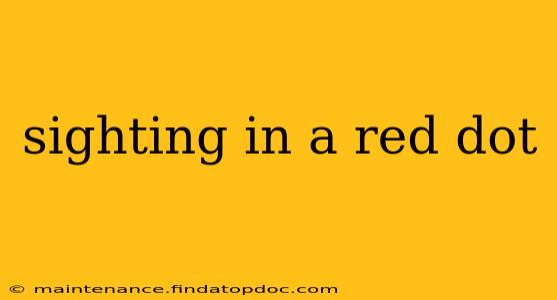Red dot sights have revolutionized firearms accuracy and speed, offering a fast target acquisition system favored by hunters, sport shooters, and self-defense enthusiasts alike. However, maximizing their potential requires proper sighting-in, a process that ensures your red dot is accurately aligned with your firearm's barrel. This comprehensive guide covers everything you need to know, from the necessary tools and equipment to troubleshooting common issues.
What Tools Do I Need to Sight In a Red Dot?
Before you begin, gather the following essentials:
- A safe shooting environment: This is paramount. Choose a range with proper backstops and a clear understanding of safety protocols.
- Your firearm and red dot sight: Ensure your firearm is properly cleaned and functioning correctly.
- Ammunition: Use the same type of ammunition you intend to use in the field. Consistent ammunition ensures accurate results.
- Targets: Use targets specifically designed for sighting in firearms. These typically have clear aiming points.
- Tools for adjusting the red dot: Most red dot sights use windage (horizontal) and elevation (vertical) adjustment turrets. Understand how these adjustments work on your specific sight. Usually, a small screwdriver is needed.
- Hearing and eye protection: Always prioritize safety.
- A shooting rest (optional but recommended): A rest helps minimize movement and improves accuracy during the sighting-in process.
How Far Should I Sight In My Red Dot?
The ideal distance for sighting in a red dot sight is typically 25 yards. This distance provides a good balance between practicality and the ability to detect minor adjustments. While some sources suggest shorter distances, 25 yards gives you a better representation of how your red dot will perform at longer ranges. However, you can adapt based on your firearm and intended use.
What Are the Steps to Sighting In a Red Dot Sight?
The process involves a systematic approach:
-
Zeroing the Red Dot: Begin by roughly centering the red dot in your sight picture. This is your starting point. Don't worry about perfect precision at this stage.
-
Firing a Test Group: Fire a three-shot group at your target. Note the point of impact (POI) relative to your point of aim (POA).
-
Adjusting for Windage and Elevation: Based on the POI, adjust the windage and elevation turrets. Most sights use ¼ MOA (minute of angle) or ½ MOA clicks per adjustment. Consult your sight's manual for precise instructions. Remember, right-to-left adjustments affect windage, and up-to-down movements affect elevation.
-
Iterative Adjustments: After making adjustments, fire another three-shot group. Repeat the process, making smaller adjustments with each group until the POI and POA align.
-
Fine-Tuning: Once you're close, shift to one or two shots at a time to refine your accuracy. This allows for even more precise adjustments.
How Do I Know if My Red Dot is Properly Sighted In?
A properly sighted-in red dot will consistently place your shots where you aim. Ideally, all shots should be grouped closely together, ideally within a 1-inch to 2-inch circle at 25 yards. However, this can vary based on the shooter, firearm, and ammunition used.
What if My Red Dot Sight is Still Off After Multiple Adjustments?
Several factors could contribute to consistent inaccuracy:
- Faulty Red Dot: Check for any damage or malfunctions in your red dot sight.
- Loose Mounting: Ensure your red dot is securely mounted to your firearm.
- Ammunition Issues: Try a different type of ammunition to rule out inconsistencies in your ammo.
- Shooter Error: Focus on proper shooting techniques, such as a consistent grip, stance, and breathing control.
Can I Sight In My Red Dot at a Shorter Distance?
While 25 yards is recommended, you can sight in at shorter distances, such as 10 yards. However, keep in mind that this might not accurately represent how the sight performs at longer ranges. It's best to verify at 25 yards after a preliminary sighting-in at a shorter distance.
What is the Best Way to Sight In a Red Dot Sight at Home?
Sighting in a red dot at home is strongly discouraged unless you have a safe and controlled environment with an appropriate backstop and clear understanding of firearm safety. It’s imperative to follow all local, state, and federal laws and regulations regarding firearm handling and usage. A shooting range is the safest and most appropriate place for this activity.
This detailed guide provides a strong foundation for effectively sighting in your red dot sight. Remember, patience and practice are key to achieving optimal accuracy. Always prioritize safety and adhere to responsible gun handling practices.
